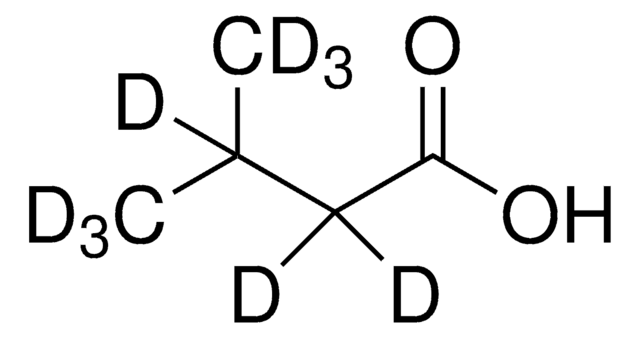129542
Isovaleric acid
99%
Synonyme(s) :
3-Methylbutanoic acid, 3-Methylbutyric acid
About This Item
Produits recommandés
Pression de vapeur
0.38 mmHg ( 20 °C)
Niveau de qualité
Pureté
99%
Forme
liquid
Température d'inflammation spontanée
824 °F
Indice de réfraction
n20/D 1.403 (lit.)
Point d'ébullition
175-177 °C (lit.)
Pf
−29 °C (lit.)
Densité
0.925 g/mL at 20 °C (lit.)
Chaîne SMILES
CC(C)CC(O)=O
InChI
1S/C5H10O2/c1-4(2)3-5(6)7/h4H,3H2,1-2H3,(H,6,7)
Clé InChI
GWYFCOCPABKNJV-UHFFFAOYSA-N
Vous recherchez des produits similaires ? Visite Guide de comparaison des produits
Catégories apparentées
Description générale
Application
Mention d'avertissement
Danger
Mentions de danger
Classification des risques
Eye Dam. 1 - Skin Corr. 1B
Code de la classe de stockage
8A - Combustible corrosive hazardous materials
Classe de danger pour l'eau (WGK)
WGK 1
Point d'éclair (°F)
176.0 °F - Pensky-Martens closed cup
Point d'éclair (°C)
80 °C - Pensky-Martens closed cup
Équipement de protection individuelle
Faceshields, Gloves, Goggles, type ABEK (EN14387) respirator filter
Certificats d'analyse (COA)
Recherchez un Certificats d'analyse (COA) en saisissant le numéro de lot du produit. Les numéros de lot figurent sur l'étiquette du produit après les mots "Lot" ou "Batch".
Déjà en possession de ce produit ?
Retrouvez la documentation relative aux produits que vous avez récemment achetés dans la Bibliothèque de documents.
Les clients ont également consulté
Articles
Probiotics exhibit an inhibitory effect on pathogens, help prevent chronic intestinal inflammatory diseases or atopic syndromes, and support the immune system.
Notre équipe de scientifiques dispose d'une expérience dans tous les secteurs de la recherche, notamment en sciences de la vie, science des matériaux, synthèse chimique, chromatographie, analyse et dans de nombreux autres domaines..
Contacter notre Service technique










